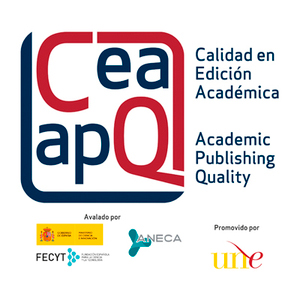The CEA-APQ Seal of Quality in Academic Publishing announces the first call for the evaluation of individual monographs
The CEA-APQ Seal of Quality in Academic Publishing announces the first call for the evaluation of individual monographs
-
14/07/2023
After the agreement signed by ANECA, FECYT and UNE last February
Applications may be submitted between 4 and 25 September

The CEA-APQ Seal of Quality in Academic Publishing is open to the evaluation of scientific monographs, following the agreement signed by ANECA, the Spanish University Publishers Union (UNE) and the Spanish Foundation for Science and Technology (FECYT) last February, and announces that the deadline for submitting applications for the first call will begin on 4 September and end on the 25th of the same month.
All monographs published by public and private entities, which present research results and which meet the nine requirements established in terms of quality and information transparency (identification of the monograph, electronic availability and inclusion of metadata), quality of the editorial policy (availability of a scientific or editorial committee and editorial policy of the publishing entity) and quality of the editorial and scientific evaluation process (instructions for the submission of manuscripts, information on the manuscript selection process, external evaluation reports and reasoned communication of the decision to publish the work) may apply for this quality recognition.
Evaluation process
Five evaluation commissions have been established for the analysis of the documentation submitted, one for each major area of knowledge: Sciences, Health Sciences, Engineering and Architecture, Social and Legal Sciences, and Arts and Humanities.
The evaluation commissions for Sciences, Health Sciences, Engineering and Architecture will be made up of a minimum of three specialists in the area and one person with expertise in scientific publishing.
The Social and Legal Sciences and Arts and Humanities committees will have twice as many members, given the foreseeable majority of monographs in these areas.
The Monitoring Committee, made up of representatives of ANECA, FECYT and UNE, will adopt the provisional and final decisions after the report issued by the Assessment Committee.
Monographs that successfully pass the evaluation process will receive the CEA-APQ Monographs Quality Seal on a permanent basis.
Indication of quality
The CEA-APQ seal has been recognised, since its creation in 2017, as an indication of the quality of publications for the evaluation of the merits of research activity, a recognition that is expressed in the evaluation criteria of the National Commission for the Evaluation of Research Activity (CNEAI), and in the evaluation criteria of ANECA for the six-year research periods and for the ACADEMIA procedure.
In the resolution of 21 December 2022 it appears as a criterion to be assessed in ten of the eleven areas of knowledge.
Rules and guide
The rules of this first call, the evaluation guide, the application manual and the necessary templates for the application process are already available at https://monografias.selloceaapq.es/
CEA-APQ Label Collections
The CEA-APQ Monographs Seal was created seven years after the Collections Seal, which recognises best practices in Spanish university publishing, promoting and stimulating quality in academic publishing and has become a sign of scientific quality recognised by research assessment agencies and the university community.
Currently 56 collections have this seal, created and developed by UNE and endorsed by ANECA and FECYT.
Extending quality
With the creation of the CEA-APQ Monographs Seal and its first call for applications, a response was given to the demand from the publishers of universities and research centres grouped together in UNE, who were calling for a certification that would accredit the scientific quality of monographs published outside collections or which form part of collections that are not in a position to achieve the seal for collections and, in this way, the research activity of their authors could be recognised.
